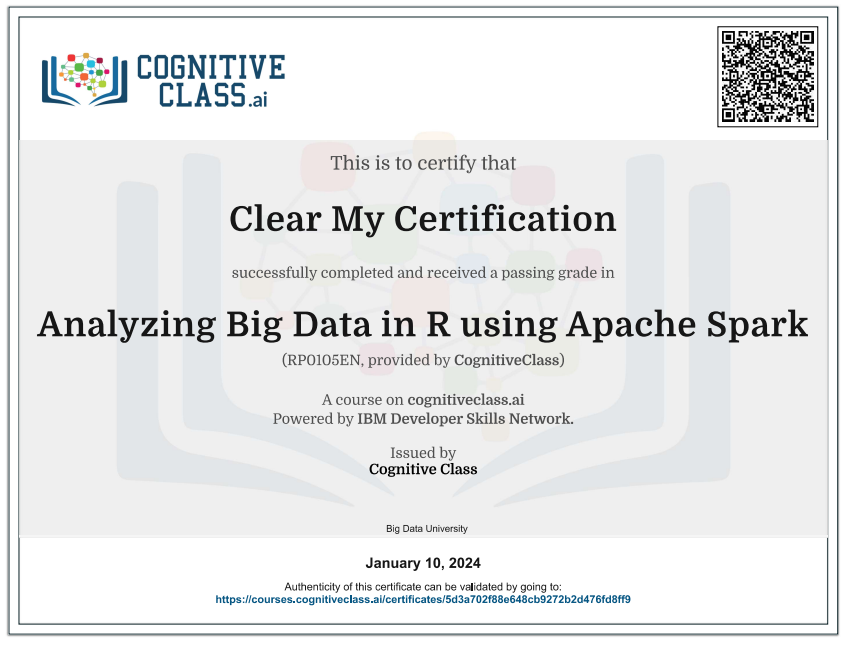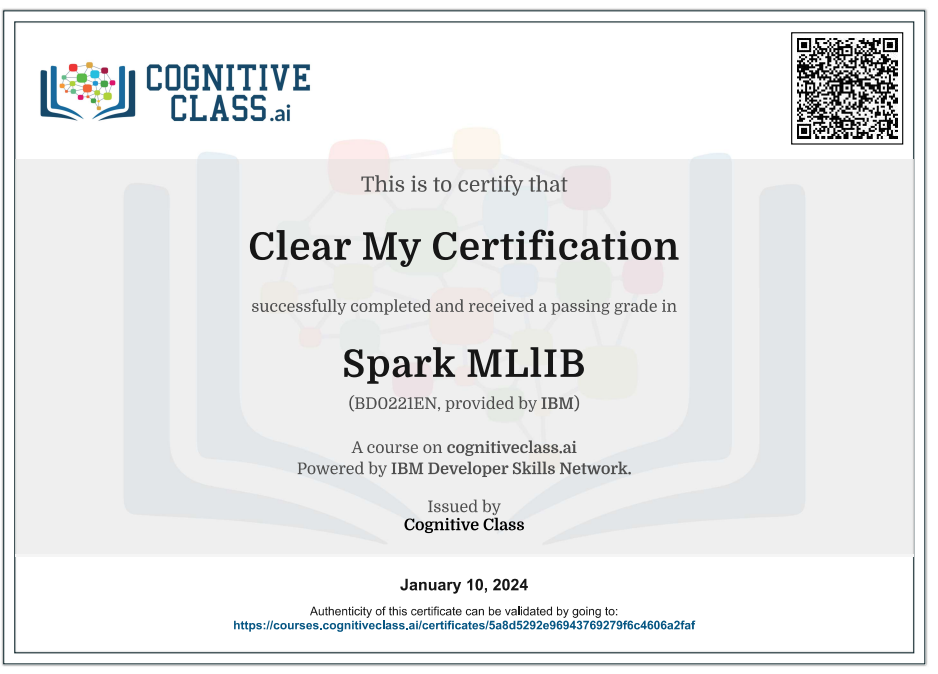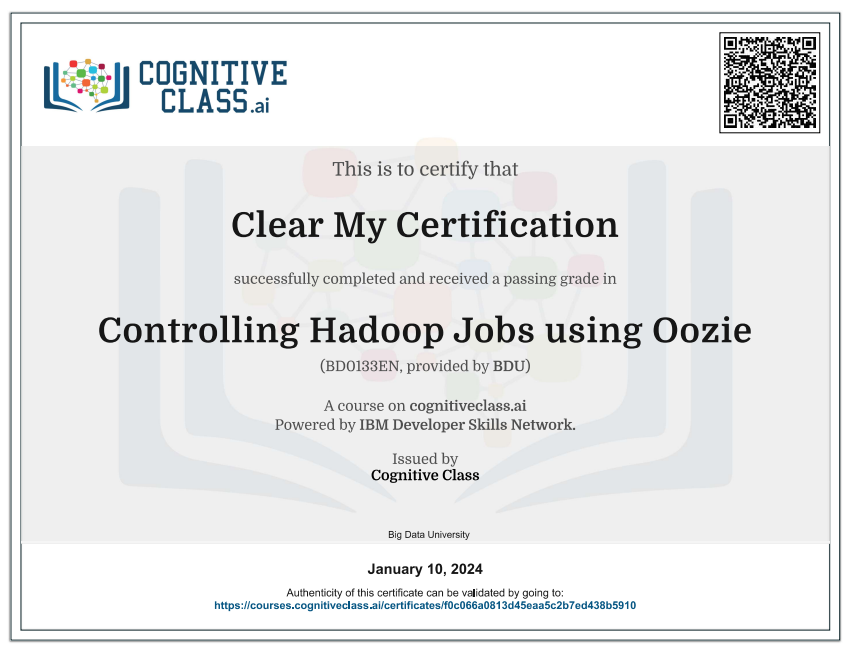Enroll Here: Serverless Computing using Cloud Functions – Developer I Cognitive Class Exam Quiz Answers
Serverless Computing using Cloud Functions – Developer I Cognitive Class Certification Answers

Module 1 – Serverless Essentials Quiz Answers – Cognitive Class
Question 1: What characteristics of serverless computing contribute to its name?
- Developers can run backend code to access databases without using servers.
- Serverless computing scales inherently to incoming events.
- Serverless computing does not use servers.
- Server management decisions are hidden from the developer.
- Serverless developers only need to configure the service framework for their chosen language.
Question 2: Serverless computing is a specific technology with a developed set of standards and practices.
- False
- True
Question 3: Serverless computing requires the developer to allocate servers and machine resources.
- False
- True
Question 4: Serverless computing scales inherently and executes stateless code in response to events.
- False
- True
Question 5: Isabelle decided to use serverless computing for a project that crops photos automatically when added to cloud storage. How would you critique her choice?
- Serverless is a great choice because it can flexibly react to incoming photos and crop them as needed.
- Serverless won’t work well here because it depends too much on how often customers will be uploading photos.
- Serverless may work well, but Isabelle will have to spend some time configuring servers to handle the infrequent uploads.
- Serverless is a great choice here because it allows Isabelle to manage the allocation of machine resources.
Question 6: You need to develop a project that is as cost-effective as possible. For which reasons would you pick serverless?
- Serverless outsourcing leads to less infrastructure, operational, and development costs.
- Serverless only charges for the time when code is executing.
- Serverless applications can run in low-cost, pre-allocated capacity you can purchase in advance.
Question 7: Long running and non-separable tasks are types of tasks that typically work well in a serverless environment.
- False
- True
Question 8: You are given the following graph of usage for an application you are developing. Which of the following is a correct conclusion of the graph?
- The usage is mostly sporadic, so serverless computing is a bad fit for this usage case.
- The usage is mostly sporadic, so serverless computing is a good fit for this usage case.
- The usage is mostly constant, so serverless computing would be a bad fit for this usage case.
- The usage is mostly constant, so serverless computing would be a good fit for this usage case.
Module 2 – Create and Invoke Action Quiz Answers – Cognitive Class
Question 1: If you were to execute the following command which invokes a Hello World action:
ibmcloud fn action invoke hello
it would return with an activation ID and an HTTP response generated by the function.
- False
- True
Question 2: When invoking actions, parameter values can be any valid JSON value, including nested objects.
- False
- True
Question 3: It is not possible to monitor activation logs in real time using the command line.
- False
- True
Question 4: It is impossible to perform a blocking invocation on an asynchronous action.
- False
- True
Question 5: If an action in the middle of a sequence fails, the platform will return the error after the last action in the sequence is invoked.
- False
- True
Module 3 – Manage Actions with Packages Quiz Answers – Cognitive Class
Question 1: You can invoke actions in public packages as if they were normal actions.
- False
- True
Question 2: You can provide default parameters to an action in a public package just as you would a normal action.
- False
- True
Question 3: If you bind a parameter value to a package, that value cannot be overridden on invocation.
- False
- True
Question 4: After creating a custom package as private, you can update the package to make it public.
- False
- True
Module 4 – Connect Actions to Event sources Quiz Answers – Cognitive Class
Question 1: What is a trigger?
- An API that invokes a function
- A network connection between an event source and a function
- A named channel for a class of events
- Event data that is sent to functions as key-value pairs
Question 2: What is the purpose of a rule?
- associates multiple triggers with a single action
- associates a single trigger with a single action
- associates a single trigger with multiple actions
Question 3: Rules allow you to define conditional logic that controls if an action gets invoked based upon event data.
- True
- False
Question 4: Multiple actions can be fired from a single trigger.
- Correct
- Incorrect
Module 5 – Expose Actions as APIs Quiz Answers – Cognitive Class
Question 1: Any action can be made accessible on the web by simply setting the flag –web to true.
- False
- True
Question 2: Functions that are web actions need to parse the raw HTTP request header to obtain query parameters.
- False
- True
Question 3: Which command would you use to retrieve the HTTP endpoint for a web action?
- ibmcloud fn api get <action_name> –url
- ibmcloud fn action get <action_name> –url
- ibmcloud fn api get <action_name> –http
- ibmcloud fn action get <action_name> –http
Question 4: If you have a web action that returns a JSON object, the caller must append .json to the web action’s URL to get a successful response.
- False
- True
Module 6 – Use the Web User Interface (web UI) Quiz Answers – Cognitive Class
Question 1: When using the ICF Web UI, you can accomplish almost everything you can using the CLI.
- False
- True
Question 2: The ICF Web UI provides access to logs and action metrics.
- False
- True
Serverless Computing using Cloud Functions – Developer I Final Exam Answers – Cognitive Class
Question 1: ICF scales your actions automatically only in response to event triggers.
- False
- True
Question 2: You are given the following graph of usage for an application you are developing. Which of the following is a correct conclusion of the graph?
- The usage is mostly sporadic, so serverless computing is a bad fit for this usage case.
- The usage is mostly sporadic, so serverless computing is a good fit for this usage case.
- The usage is mostly constant, so serverless computing would be a bad fit for this usage case.
- The usage is mostly constant, so serverless computing would be a good fit for this usage case.
Question 3: Tobias is trying to create an image recognition model for object analysis using large amounts of raw image data. Is serverless a good choice in helping with these tasks?
- Serverless may be a good choice in both dividing the data into manageable pieces as well as analyzing the data in parallel.
- Serverless won’t work well here because processing the large amount of raw data would be too costly.
- Serverless is not a good choice because Tobias would need dedicated servers that have the processing power for analytics.
- Serverless is a great choice here, but Tobias will have to configure his account to handle the amount of processing needed.
Question 4: Actions cannot directly invoke other actions without using a sequence.
- False
- True
Question 5: You are able to pass parameters when invoking an action using the command line directly or indirectly using a parameter file.
- False
- True
Question 6: If you have many packages of actions, you can better organize them by creating a package that contains several similar packages.
- False
- True
Question 7: Multiple triggers can be configured to fire the same action.
- Correct
- Incorrect
Question 8: It may be possible to construct a website entirely using serverless actions.
- False
- True
Question 9: If you wish to monitor your action invocations, you need to use the Web UI.
- False
- True
Introduction to Serverless Computing using Cloud Functions – Developer I
Serverless computing is a cloud computing model that allows developers to build and run applications without managing the underlying infrastructure. Cloud Functions, offered by various cloud providers such as Google Cloud Platform (GCP), Amazon Web Services (AWS), and Microsoft Azure, are a popular implementation of serverless computing. In this response, I’ll provide an overview of Serverless Computing using Cloud Functions, specifically focusing on Google Cloud Platform.
Google Cloud Functions:
Google Cloud Functions (GCF) is a serverless compute service that automatically scales, allocates resources as needed, and charges only for the compute time used. Here’s a guide for developers (Developer I) getting started with Google Cloud Functions:
- Prerequisites:
- Ensure you have a Google Cloud Platform (GCP) account.
- Install the Google Cloud SDK on your local machine.
- Create a Project:
- In the Google Cloud Console, create a new project.
- Enable Cloud Functions API:
- Navigate to the Cloud Functions section in the Cloud Console.
- Enable the Cloud Functions API for your project.
- Install and Configure Google Cloud SDK:
- Open a terminal and run
gcloud initto configure your SDK with your GCP account and project.
- Open a terminal and run
- Create a Cloud Function:
- Write a simple function in your preferred programming language (Node.js, Python, Go, etc.).
- Deploy the function using the
gcloud functions deploycommand.
- Trigger Configuration:
- Define triggers for your function (e.g., HTTP, Cloud Storage, Pub/Sub).
- Configure function settings such as memory allocation, timeout, etc.
- Testing:
- Test your Cloud Function by invoking the trigger (e.g., sending an HTTP request).
- Review logs and monitoring data in the Cloud Console.
- Manage Dependencies:
- If your function relies on external libraries, ensure they are specified in your deployment configuration.
- Security:
- Implement proper authentication and authorization mechanisms.
- Configure function permissions and IAM roles.
- Monitoring and Logging:
- Set up monitoring and logging to track the performance and behavior of your functions.
- Cost Management:
- Understand the pricing model of Cloud Functions.
- Utilize features like budget alerts to manage costs effectively.
- Scaling:
- Cloud Functions automatically scales based on demand, but understand how scaling works to optimize performance.
- Continuous Deployment:
- Integrate your deployment process with CI/CD pipelines for seamless updates.
 Clear My Certification All Certification Exam Answers
Clear My Certification All Certification Exam Answers



